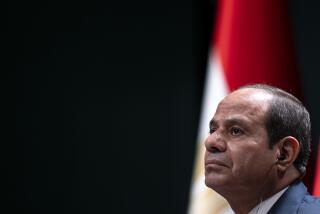Obama’s strategy was to pressure Mubarak without intruding
Flying home from Michigan on Air Force One, President Obama sat in front of a television and watched Hosni Mubarak deliver a surprising speech: He would not quit.
Earlier in the day, Obama had told an audience that “we are witnessing history unfold,” a sign that he understood the Egyptian president would resign. Now Obama was watching a defiant Mubarak announce that he was transferring some presidential powers but would remain in office.
Returning to the White House, Obama summoned Vice President Joe Biden and top foreign policy aides to the Oval Office. The president was perplexed. They pored over English translations of Mubarak’s address, trying to parse the language to determine exactly what he’d said. They searched printouts of a speech that Egyptian Vice President Omar Suleiman had delivered shortly afterward, trying to discern precisely what powers Mubarak had transferred.
An hour later, Obama delivered his verdict: Not good enough. The Mubarak speech did not satisfy the president, nor would it calm the protesters who were demanding change.
His staff raced to craft a sharply worded response. Obama phoned Defense Secretary Robert M. Gates and Secretary of State Hillary Rodham Clinton, read a draft to them and asked for suggestions.
Obama’s position: Mubarak’s plan was not “immediate, meaningful or sufficient.”
The White House’s handling of that moment hewed to a strategy developed after the crisis erupted Jan. 25. Determined to be on “the right side of history” without intruding in Egypt’s political affairs, Obama wanted to put pressure on the dictator, squeezing Mubarak to hand over power and begin the transition to a more democratic country.
Obama never publicly called for Mubarak to resign. The White House feared that approach could backfire. Obama’s advisors did not want to give the impression Washington had forced change in another country. And they worried that conservative elements in the Egyptian regime might prop up Mubarak in response to U.S. demands that he go.
“We didn’t want to leave much doubt that [Mubarak’s departure] was certainly something we thought would be a positive way forward,” said an Obama advisor, who was heavily involved in crafting the administration strategy and spoke on condition of anonymity. “But we wouldn’t be the ones to call for it. That was the line we tread.”
Private messages were more direct.
On Feb. 1, Mubarak appeared on state television and announced that he would not run for reelection. From the Situation Room in the White House basement, Obama watched what was billed by the Egyptians as a concession.
He and his aides debated what to do. If the White House dismissed that move as inadequate, it could mean a permanent break with Mubarak, a longtime ally who had helped secure an uneasy peace in the Middle East.
The president decided he wanted to talk to Mubarak.
He went upstairs to the Oval Office and made a call, which officials now describe as one of the most difficult conversations Obama has had with a foreign leader.
The two men spoke for 30 minutes. Sticking to his strategy, Obama told Mubarak his reforms didn’t go far enough, and that he risked aggravating an already tense situation.
Obama was blunt. He told Mubarak that “there needed to be a change in leadership in Egypt” and it needed to come within days, the senior official said.
The White House believed that resignation was the clearest way to signal a break with the past, but it was open to options, including a transitional arrangement in which Mubarak would hand over some powers while retaining the office of president.
When Obama speaks to foreign leaders, he typically finds common ground on at least some points, according to aides. Not this time.
“I will just say it was a difficult conversation,” the senior official said. “The president hasn’t spoken to Mubarak since.”
The president hung up and made a public statement in the grand foyer of the White House, hinting at his impatience by calling for the transition in Egypt to “begin now.”
Then the U.S. message began to stray.
Early in the crisis the administration had dispatched Frank Wisner, a former ambassador to Egypt who was friendly with Mubarak, to Cairo to meet with the Egyptian leader and convince him that it was time to step aside. Mubarak refused.
But on Feb. 5, Wisner spoke during a security conference in Munich and said that Mubarak needed to stay in power to help guide the transition to democracy. With the crisis deepening, that was a departure from the message the U.S. wanted to convey, the administration official said.
The following day, Clinton, in an interview, said that countries evolve “at different paces” and that it was not unusual for the U.S. to have dealings with governments it does not especially like, which observers saw as a signal that the administration was advocating a go-slow approach.
In combination, the two statements suggested that the U.S. was getting too far out of step with the protesters’ demand for Mubarak to leave.
The Wisner statement, in particular, was “a low point,” the administration official said, creating “a perception of our policy that wasn’t true.”
In an e-mail message Saturday, Wisner responded: “I beg to differ.” He declined to elaborate.
For the next two days, the White House worked to clarify its message and speak with one voice. It made public the details of a phone call in which Biden spoke candidly with his Egyptian counterpart, Suleiman, whom the U.S. viewed as key to the transition.
The call portrayed Biden as pressing Suleiman for an “immediate, irreversible progress that responds to the aspirations of the Egyptian people.”
By Thursday, the day of Obama’s trip to Michigan, Egyptian officials were telling their U.S. counterparts that Mubarak would resign in a televised speech that night. In Washington, CIA Director Leon Panetta said in a congressional hearing that there was “a strong likelihood” that Mubarak was on the way out.
But Mubarak held on one last night.
U.S. officials worked through the night, making numerous calls to their counterparts in Cairo that went unanswered. The drama had become an Egyptian affair.
Hours later, the Egyptian military forced Mubarak out, unleashing scenes of jubilation in Cairo that flashed around the world.
Obama left a meeting to watch the celebrations on a television outside the Oval Office. Then he sat down with aides to plan the speech he would make. He asked them to include vignettes from the Cairo streets. And he wanted to note that the protests were nonviolent, in the spirit of Gandhi and Martin Luther King.
“We saw protesters chant ‘Selmiyya, selmiyya’ — ‘We are peaceful’ — again and again,” the president said in the seven-minute address.
It was Obama at his most eloquent, lauding Egyptian demonstrators who peacefully “bent the arc of history toward justice once more.”
But he also included a pointed message for the military leaders who now were in charge. He would be watching, he warned them, for a “transition that is credible in the eyes of the Egyptian people.”
There were no celebrations at the White House; no champagne toasts on the Truman Balcony like the one Obama hosted after Congress passed his healthcare overhaul last year. The administration has been busy making calls to senior Egyptian officers, trying to keep the pressure on.
A White House aide said: “This is hardly over.”
More to Read
Get the L.A. Times Politics newsletter
Deeply reported insights into legislation, politics and policy from Sacramento, Washington and beyond. In your inbox three times per week.
You may occasionally receive promotional content from the Los Angeles Times.










